Maasai
Ceremonies and Rituals
There
are many ceremonies in Maasai society including Enkipaata
(senior boy ceremony), Emuratta (circumcision), Enkiama
(marriage), Eunoto (warrior-shaving ceremony), Eokoto
e-kule (milk-drinking ceremony), Enkang oo-nkiri
(meat-eating ceremony), Olngesherr (junior elder ceremony),
etc. Also, there are ceremonies for boys and girls minor including,
Eudoto/Enkigerunoto oo-inkiyiaa (earlobe), and Ilkipirat
(leg fire marks). Traditionally, boys and girls must undergo
through these initiations for minors prior to circumcision.
However, many of these initiations concern men while women's
initiations focus on circumcision and marriage. Men will
form age-sets moving them closer to adulthood.
Women
do not have their own age-set but are recognized by that of
their husbands. Ceremonies are an expression of Maasai
culture and self-determination. Every ceremony is a new life.
They are rites of passage, and every Maasai child is eager to
go through these vital stages of life. Following
is where a boy's life begin in the Maasai society.
Enkipaata
The
first boy's initiation is Enkipaata (pre-circumcision
ceremony), and is organized by fathers of the new age set. Enkipaata
can only happen, when the senior warriors are settled. More
on senior warriors will be discussed later in this page.
A
delegation of boys, aged 14 to 16 years of age, would travel
across their section land for about four months announcing the
formation of their new age-set. The boys are accompanied by
a group of elders spearheading the formation of a new age-set.
A
collection of 30-40 houses are built for the initiating boys.
The houses are located in one large kraal chosen by the Oloiboni
(prophet). This is where all boys across the region will
be united and initiated. Before the ceremony, the Olopolosi
olkiteng, chief of the boys, must be chosen. Olopolosi
olkiteng is a position not desired by anyone because it is considered
unfortunate. The new chief is to shoulder all of his age group's
sins. The day before the ceremony, boys must sleep outside in
the forest. When early dawn approaches, they run to the
homestead and enter with an attitude of a raider. During the
ceremony, boys dress in loose clothing and dance non-stop throughout
the day. This ceremony is the transition into a new age set.
After enkipaata ceremony, boys are ready for the most
important initiation known as Emuratare (circumcision).
Circumcision
ceremony is the most vital initiation of all rite of passages
in the Maasai society. Both men and women of the Maasai society
are traditionally eager to undergo through circumcision. This
initiation is performed shortly after puberty.
It
is important to note that with the rising challenges of the
21st century in the Maasai society, many young Maasai women
no longer undergo through circumcision.
Young
men are still eager to be circumcised and become warriors. Once
the boys become warriors they resume responsibility of security
for their territory.
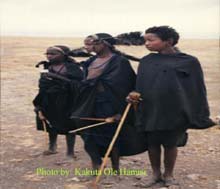 Circumcision
initiation elevates an individual from childhood
to adulthood. In order for the boy to be initiated he must prove
himself to the community. The boy must exhibit signs of a grown
man, by carrying a heavy spear, herding large herd of livestock,
etc.
Circumcision
initiation elevates an individual from childhood
to adulthood. In order for the boy to be initiated he must prove
himself to the community. The boy must exhibit signs of a grown
man, by carrying a heavy spear, herding large herd of livestock,
etc.
A
few days before the operation, a boy must herd cattle for seven
consecutive days. Circumcision would take place
on the eighth day. Before the operation, boys must stand outside
in the cold weather and receive a cold shower to cleanse himself.
As he moves towards the location of the operation, his friends,
age mates and male members of the family shout encouragement
along with nasty looks and sometimes threats. For example, people
would tell the boy, "If you kick the knife, we will kill you!
If you run away from the knife, your society will disown you.
Women are luckier and are spared of such comments. Needles to
say, circumcision is not pleasant. No
pain relief drugs such as anesthesia, and you cannot flinch
your eye. Circumcision is painful yet means
a lot to every Maasai.
Time
and Place of Circumcision
Circumcision
takes place shortly before sunrise. It is performed
by a qualified man with many years of experience. After the
operation is successfully completed, the boy would receive gifts
of livestock from his relatives and friends. He would also gain
a tremendous amount of respect for his bravery. Women's operation
is performed slightly different than the men's. Note:
Due to respect for my culture and its gender boundaries,
as a man, I am not permitted to discuss details about women's
initiation.
The
healing process will take 3-4 months, and boys must remain in
black cloths for a period of 4-8 months. After they are healed,
they have become a new person and receive the status of a new
warrior.
 After
circumcision, the next step is to form the Emanyatta
(warrior's camp).
After
circumcision, the next step is to form the Emanyatta
(warrior's camp).
Emanyatta
contains twenty to forty houses randomly selected by warriors.
The selection of this camp is sometimes a bit of a challenge.
Not every elder would like his wife to be in an emanyatta, because
it is a free visit zone for everyone. Jealous husbands are more
likely to refuse to participate in the camp; they think that
their wives' former lovers will take advantage of her. Therefore,
warriors sometimes fights with their jealous fathers. Weapons
such as spears, clubs and shields are carried by warriors during
this time because, occasionally, the battle can get very serious.
Warriors will choose certain mothers to relocate at the emanyatta
for the duration of its existence. Each Maasai section has its
own age-set. The two most common camps are Ilaiserr
and Irmolelian (clans); however, it is common
for a section to have more than two emanyatta camps.
A
special pole, planted in the middle of the camp, is used as
a flagpole. The white and blue colored cloth, the Maasai nation's
flag, is tied to the pole before planting, and remains there
as long as the Morrans (warriors) are still in
the camp. (This is the first time in history for the age set
to combine the Kenya national flag and the Maasai flag.) Two
morran chiefs are chosen to lead, guide and represent their
camp. The purpose of the camp is to keep men of the same age
set together and fulfill their role as a military force. This
is where the warriors learn about the age set brotherhood, the
art of oratory skills and animal husbandry. They will spend
up to ten years in the emanyatta before the Eunoto
ceremony (senior's warrior initiation).

Like many other eroding Maasai cultural customs,
the emanyatta is not left unscathed. Many attempts have been
made by the outside world to end this traditional custom because
it is seen as backward. However, even though the government
frowns on warrior hood, it also uses its image to attract tourists.
The emanyatta ceremony that we presented in The Maasai and
Agents of change is probably the last of its kind. Fire
stick, honey and blue beads are other rituals performed
in the Manyatta (warriors camp) and play an important role in
the Orporror (morrans age group). After
the emanyatta camp the warriors would head for eunoto ceremony
(senior warrior's initiation).
Eunoto
The
Eunoto ceremony is performed by members of the age set,
ten years after warriorhood. It marks the status of a warrior
transitioning to a senior warrior. This initiation also permits
senior warriors to marry, which in turn prepares them to become
future fathers. The ceremony takes place in another specially
chosen camp that includes a total of forty-nine houses. The
forty ninth house is known as Osinkira, a large
mud hut made specificaly for the Oloiboni. Warriors on a daily
basis will entertain the Oloiboni until the event
is over. Every graduating warrior must shave his long ochre-stained
hair, which is done by the warrior's mother. During the festival,
warriors are prohibited to carry weapons such as sticks, spears,
knifes, etc. Also, during this event, an animal horn is set
on fire and warriors are forced to take a piece out before it
is completely burned. No one wants to take the piece out, because
whoever takes the horn out of the fire will suffer misfortunate
throughout his entire life. However, if warriors refuse to take
the horn out from the fire, the entire age-set will be cursed.
It is better for one person to be unfortunate than many.
Warriors
must raise eight bulls, before the ceremony, to be distributed
to the elders at the graduation day. Three important leaders
must be chosen by the warriors before the ceremony; Olaiguanani
lenkashe, Oloboru enkeene and Olotuno (the
initiate one). No one would like to be one of these leaders,
particularly the Olotuno. This person shoulders all of
his age set's bad and good deeds. The Olaiguanani lenkashe
is honored with a specially chosen female cow; Oloboru enkeene
is honored with a leather strap with a knot that symbolizes
his age set. By the end of warrior-hood, this knot will be untied
to free the warriors from their isolated world. The knot allows
warriors to do things independently from other age mates. This
stage of life is a transition to an elder.
A
few months after the Eunoto, warriors form a small
camp for Enkang e-kule, the milk ceremony. Before
the Eunoto ceremony, warriors are prohibited to
eat alone without the company of 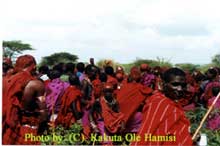 others.
Excuses are not accepted; even the sick must obey the requirement.
To drink outside the camp is allowed but only if women are not
present. Such social taboos are established by the Maasai to
teach young men to be self-reliant rather than dependent on
their mothers who mostly prepare food for her husband and the
young ones. Also, such taboos train and prepare warriors
to adapt to harsh environmental conditions such as famine etc.
The milk ceremony requires the entire age set to shave their
red ochre stained hair. It is the mother's role to shave her
graduating son. No warrior will shave his hair before his highly
respected age set chiefs. Many of them prefer to graduate on
the same day as their chiefs. For the first time, warriors feel
awkward and shameful to eat in front of their female lovers.
It takes a while for them to get used to this. After the
milk ceremony, warriors undergo minor bouts of emotional stress,
because they are disbarred from the world of warrior hood.
others.
Excuses are not accepted; even the sick must obey the requirement.
To drink outside the camp is allowed but only if women are not
present. Such social taboos are established by the Maasai to
teach young men to be self-reliant rather than dependent on
their mothers who mostly prepare food for her husband and the
young ones. Also, such taboos train and prepare warriors
to adapt to harsh environmental conditions such as famine etc.
The milk ceremony requires the entire age set to shave their
red ochre stained hair. It is the mother's role to shave her
graduating son. No warrior will shave his hair before his highly
respected age set chiefs. Many of them prefer to graduate on
the same day as their chiefs. For the first time, warriors feel
awkward and shameful to eat in front of their female lovers.
It takes a while for them to get used to this. After the
milk ceremony, warriors undergo minor bouts of emotional stress,
because they are disbarred from the world of warrior hood.
The
next initiation is Enkang oo-nkiri (meat ceremony/initiation
camp), which is performed in a selected camp that contains ten
to twenty houses. The selected houses are from wives of the
initiating junior elders. This camp is located in a convenient
location near the home of a friendly age mate. The age-set is
allowed to have as many meat camps as they need throughout the
region.
The
meat ceremony permits warriors to eat by themselves meat prepared
by women of the homestead. Every graduating warrior is anxious
to see this date. A specially chosen bull is slaughtered for
the ceremony. A wife must prove to her husband that she hasn't
engaged in an illegal sexual affair with a man of the younger
age set. Whether this has occurred or not will be revealed
by participating in the bull's skin ritual. Men wrestle with
themselves to get near the bull's skin to see if their wives
have been unfaithful to the age-set. It is right for a wife
to have affairs with men of the same age set but not outside
the age set. If a woman is found guilty of violating such a
commitement, she will be disrespected by her husband and by
her entire age set.
For
a woman to regain respect from her husband, she must go back
to her father or relativ's home to obtain a female cow. No man
would refuse such an apology; however, the man might not keep
the cow. he would then give the cow to his friend as a gift.
At
the end of the meat ceremony, men and women fight against one
another for the specially roasted meat. Warriors who violated
their age set taboos and laws are punished before this event
takes place.
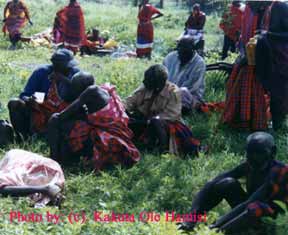 The
last age set's initiation is Orngesherr (junior's
elder initiation) and marks the status of a junior elder. It
is performed in a selected camp that contains twenty or more
houses. Every one in the age set looks forward to this final
initiation. Every man is honored with an elder's chair in this
ceremony. In the early morning of the day of the event, he will
sit on the chair and be shaved by his wife. If a man has more
than one wife, it is the older wife's responsibility to shave
the husband. This chair becomes a man's friend until it is broken.
If a man dies before the chair breaks, his older son will adopt
the chair. After this ceremony, a man would become an
elder and would assume full responsibility of his own family.
He is now allowed to move away from his father's homestead and
form his own homestead. However, even though the man is now
an indipendent man, he would still have to rely on his father's
advice. A man would assume total responsibility of his family
at the age of about 35 years.
The
last age set's initiation is Orngesherr (junior's
elder initiation) and marks the status of a junior elder. It
is performed in a selected camp that contains twenty or more
houses. Every one in the age set looks forward to this final
initiation. Every man is honored with an elder's chair in this
ceremony. In the early morning of the day of the event, he will
sit on the chair and be shaved by his wife. If a man has more
than one wife, it is the older wife's responsibility to shave
the husband. This chair becomes a man's friend until it is broken.
If a man dies before the chair breaks, his older son will adopt
the chair. After this ceremony, a man would become an
elder and would assume full responsibility of his own family.
He is now allowed to move away from his father's homestead and
form his own homestead. However, even though the man is now
an indipendent man, he would still have to rely on his father's
advice. A man would assume total responsibility of his family
at the age of about 35 years.
It
is important to note that many of these initiations and rituals
have been eroding due to outside influences. We are told to
abandon our way of life and to embrace western ways of life,
which has been deem reliable and sufficient to ours. Our culture
remains uncertain in the face of modernism, western religion,
and environmental challlenges.
"It takes one day to destroy a house; to build
a new house will take months and perhaps years. If we abandon
our way of life to construct a new one, it will take thousands
of years", Maasai belief.
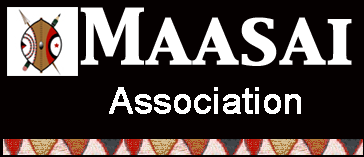
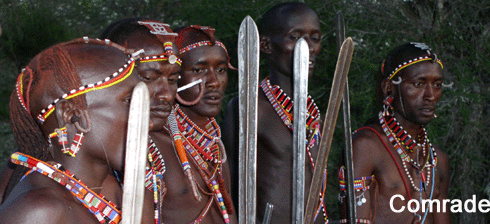
 Circumcision
initiation elevates an individual from childhood
to adulthood. In order for the boy to be initiated he must prove
himself to the community. The boy must exhibit signs of a grown
man, by carrying a heavy spear, herding large herd of livestock,
etc.
Circumcision
initiation elevates an individual from childhood
to adulthood. In order for the boy to be initiated he must prove
himself to the community. The boy must exhibit signs of a grown
man, by carrying a heavy spear, herding large herd of livestock,
etc.
 After
circumcision, the next step is to form the Emanyatta
(warrior's camp).
After
circumcision, the next step is to form the Emanyatta
(warrior's camp).

 others.
Excuses are not accepted; even the sick must obey the requirement.
To drink outside the camp is allowed but only if women are not
present. Such social taboos are established by the Maasai to
teach young men to be self-reliant rather than dependent on
their mothers who mostly prepare food for her husband and the
young ones. Also, such taboos train and prepare warriors
to adapt to harsh environmental conditions such as famine etc.
The milk ceremony requires the entire age set to shave their
red ochre stained hair. It is the mother's role to shave her
graduating son. No warrior will shave his hair before his highly
respected age set chiefs. Many of them prefer to graduate on
the same day as their chiefs. For the first time, warriors feel
awkward and shameful to eat in front of their female lovers.
It takes a while for them to get used to this. After the
milk ceremony, warriors undergo minor bouts of emotional stress,
because they are disbarred from the world of warrior hood.
others.
Excuses are not accepted; even the sick must obey the requirement.
To drink outside the camp is allowed but only if women are not
present. Such social taboos are established by the Maasai to
teach young men to be self-reliant rather than dependent on
their mothers who mostly prepare food for her husband and the
young ones. Also, such taboos train and prepare warriors
to adapt to harsh environmental conditions such as famine etc.
The milk ceremony requires the entire age set to shave their
red ochre stained hair. It is the mother's role to shave her
graduating son. No warrior will shave his hair before his highly
respected age set chiefs. Many of them prefer to graduate on
the same day as their chiefs. For the first time, warriors feel
awkward and shameful to eat in front of their female lovers.
It takes a while for them to get used to this. After the
milk ceremony, warriors undergo minor bouts of emotional stress,
because they are disbarred from the world of warrior hood.
 The
last age set's initiation is Orngesherr (junior's
elder initiation) and marks the status of a junior elder. It
is performed in a selected camp that contains twenty or more
houses. Every one in the age set looks forward to this final
initiation. Every man is honored with an elder's chair in this
ceremony. In the early morning of the day of the event, he will
sit on the chair and be shaved by his wife. If a man has more
than one wife, it is the older wife's responsibility to shave
the husband. This chair becomes a man's friend until it is broken.
If a man dies before the chair breaks, his older son will adopt
the chair. After this ceremony, a man would become an
elder and would assume full responsibility of his own family.
He is now allowed to move away from his father's homestead and
form his own homestead. However, even though the man is now
an indipendent man, he would still have to rely on his father's
advice. A man would assume total responsibility of his family
at the age of about 35 years.
The
last age set's initiation is Orngesherr (junior's
elder initiation) and marks the status of a junior elder. It
is performed in a selected camp that contains twenty or more
houses. Every one in the age set looks forward to this final
initiation. Every man is honored with an elder's chair in this
ceremony. In the early morning of the day of the event, he will
sit on the chair and be shaved by his wife. If a man has more
than one wife, it is the older wife's responsibility to shave
the husband. This chair becomes a man's friend until it is broken.
If a man dies before the chair breaks, his older son will adopt
the chair. After this ceremony, a man would become an
elder and would assume full responsibility of his own family.
He is now allowed to move away from his father's homestead and
form his own homestead. However, even though the man is now
an indipendent man, he would still have to rely on his father's
advice. A man would assume total responsibility of his family
at the age of about 35 years.